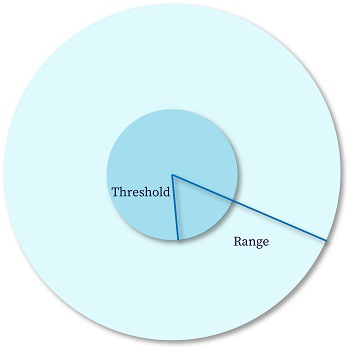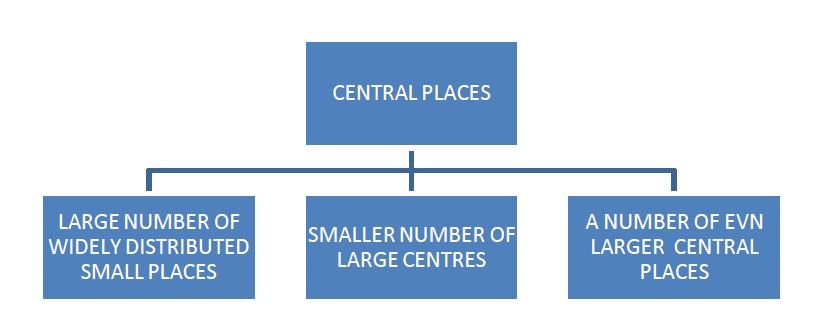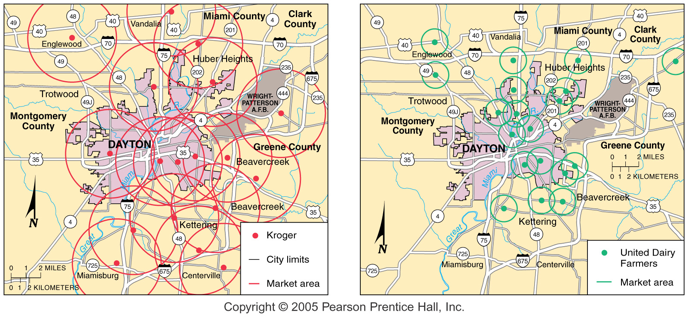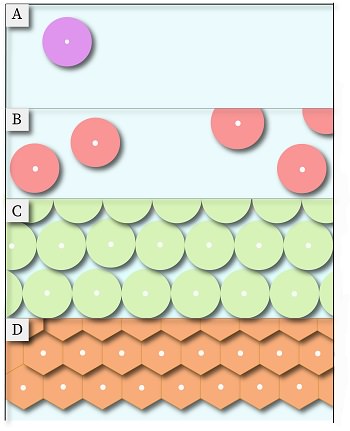
Introduction to Christaller’s Central Place Theory (CPT)
A Location Theory
Central place theory was given by Walter Christaller in 1933, CPT in urban geography is one of the most appreciated theories which tries to explain the spatial arrangements and distribution of human settlements and their number based on population and distance from another human settlement. This theory was first given by German geographer Walter Christaller in 1933, on the basis of his study of settlement patterns in southern Germany. This study included the analyzing the relationships between settlements of different sizes and related their economic activities (market) with the population. This article will explain what is central place theory.
Walter Christaller explained why the highest order settlement has very peculiar activities which can only be supported by them and the reason behind those activities taking place only in those particular highest order settlements, he also explained the nature of activities in different order of settlements. Central place theory is of great importance even after decades and forms the basis of various present-day theories used in urban planning.
Assumptions of Christaller’s Central place theory
Christaller made some assumptions to make his theory easy to understand and form the basis for other theories. These assumptions were necessary and hold good to explain the structure of settlements. These also take into account the growth and development of towns, human behavior and fundamentals of economics. Walter Christaller made following assumptions:
- An even (flat) terrain – A hilly and uneven terrain poses difficulty in development thus a flat area which promotes the growth of the town
- Evenly distributed population – residents are not concentrated at one particular place and no preference exists for a particular town
- Evenly distributed resources – no place has an advantage of resources, all placed will compete under perfect market conditions
- Similar purchasing power – along with the population and resources, wealth is also fairly distributed. Because of this people have similar purchasing power
- Preference for the nearest market – people will buy products from the nearest market and avoid the long commute. This keeps price constant as per other assumptions
- Equal transportation cost (proportional to distance) – the cost incurred in transporting of goods is equal for all and is proportional to the distance
- Perfect competition – price is decided on basis of demand and supply. People will buy at the lowest price which market has to offer, no seller has an advantage over another seller.
These assumptions when combined, results in place offering different services. In these places in which people enjoy the perfect market and purchase from the nearest place to save on money and time. Different services locate themselves on the basis of the threshold population. The minimum number of people required to sustain that service/activity. In addition to this, there is no preference for a particular shop. All people have access to equal resources and do not enjoy any advantage over its competitor. The demand for goods consumed & used on daily basis will be used more and vice versa.
Explanation of terms: Central Place definition, low order, high order, sphere of influence
- A Central Place is a settlement which provides one or more services for the population living around it.
- Simple basic services (e.g. grocery stores) are said to be of low order. Specialized services (e.g. universities) are said to be of high order.
- Having a high order service implies there are low order services around it, but not vice versa.
- Settlements which provide low order services are said to be low order settlements.
- Settlements that provide high order services are said to be high order settlements.
- The sphere of influence is the area under the influence of the Central Place.

Two main concepts of Central Place Theory
As per Walter Christaller, Central Place Theory is based on 2 fundamental concepts which are “Threshold” and “Range”
Threshold – The minimum population needed to make a service viable at a particular place. If this size is not reached then a particular activity will not start or it will be closed down.
Range – This is the maximum distance a consumer is willing to travel to purchase good or avail a service, beyond this distance consumer will not travel as the distance traveled for good/service will outweigh the benefit.
From these two concepts, the lower and upper limits of goods or services can be found. With the upper and the lower limits, it is possible to see how the central places are arranged in an imaginary area.
Sizes of settlements/communities as per central place theory
Walter Christaller gave a system with 5 sizes of settlements based on population. The smallest unit is Hamlet which is considered a rural community and the largest unit is Regional Capital. The rank order of central places in ascending order include:
- Hamlet
- Village
- Town
- City
- Regional Capital/ Metropolis
Markets and Services tend to be nested hierarchies with smaller towns serving smaller markets. However, transportation and border effects can shift the distribution of towns away from theoretical uniformity.
The arrangement of the Central places/ settlements:
As transport is equally easy in all direction, each central place will have a circular market area as shown in C in the above diagram.
Principles in the arrangement of the central places:
Christaller’s theory gives 3 principles which are the marketing principle, transport principle and administrative principle for orderly arrangements and the formation of hierarchy. Settlements are regularly spaced – equidistant spacing between same order centers, with larger centers farther apart as compared to smaller centers. The market area is hexagonal shaped as it is free from overlapping, most efficient in both number and function.
The different layouts predicted by Christaller have K- values which show how much the Sphere of Influence of the central places takes in — the central place itself counts as 1 and each portion of a satellite counts as its portion:
- Marketing Principle (K=3)
- Transport Principle/ Traffic Principle (K=4)
- Administrative Principle (K=7)

The three principles of central place theory are as follows
Marketing Principle (K=3): As per this the market area of a higher order occupies one-third (1/3 part) of the market area of each of the consecutive lower size place(node) which lies on its neighbor. The lower size nodes (6 in numbers and 2nd larger circles) are located at the corner of the largest hexagon around the high-order settlement. Each high-order settlement gets 1/3rd of each satellite settlement (which are 6 in total), thus K = 1 + 6×1/3 = 3.
With K=3 the transport network is not efficient even when the distance traveled is reduced. This is because of the absence of transport links (network) between the larger places (nodes).

Transport Principle (K=4): This provides for most efficient transport network. High order place half of the market area of 6 neighboring lower order places located on the edge of the hexagon formed by high order settlement. There are maximum central places possible. These are located on the main transport routes connecting the higher order center. The transportation principle involves the minimization of the length of roads connecting central places at all hierarchy levels. In this system of nesting, the lower order centers are all located along the roads linking the higher order centers. This alignment of places along a road leads to minimization of road length. However, for each higher order center, there are now four centers of immediate lower order, as opposed to three centers under the marketing principle.

Administrative Principle (K=7): According to K = 7 administrative principle (or political-social principle), settlements are nested according to sevens. The market areas of the smaller settlements are completely enclosed within the market area of the larger settlement. Since tributary areas cannot be split administratively, they must be allocated exclusively to a single higher-order place. Efficient administration is the control principle in this hierarchy.

Hierarchy of Central Places
Christaller suggested that the central places, providing goods and services to the surrounding areas would form a hierarchy. A large number of widely distributed small places would provide lower order goods and services to service regular widespread demand. There would be a smaller number of larger centers providing both lower-order and higher-order goods and services. Successive steps of the hierarchy would consist of larger central places providing even higher-order goods and services.

Complementary Regions
Each town or city exerts its influence over surrounding areas. People come from the surrounding area to the town for goods, services, and jobs. The area over which the town exerts its influence has been termed complementary region. The term market area used in the context of specific goods and services. The larger the town, the larger is its complementary area. The larger the city, the greater the likelihood of very specialized goods and services. This attracts people from all over the world. For example, the largest cities like New York, Paris London, and Rome attract people from across the globe. Their complementary areas are international.
Example
Southern Germany displays a 7-level hierarchy of central places.

*Centrality is operationally defined by Christaller as the number of telephones in a central place minus the place’s population multiplied by the average density of telephones per population in the region. The highest order centers, those with the greatest centrality index were Frankfurt, Nuremberg, Stuttgart, Strasbourg, Zurich, and Munich.
Criticism & limitations of Christaller’s central place theory
Central Place Theory is widely appreciated and used but has its own limitations. These include the assumptions which are unrealistic. The basic assumptions are flawed. It is nearly impossible to have very large flat terrain, perfect market, and absence of preference for shopping places. Today’s economy is a capitalist economy, but government plays an equally important role which has a strong influence on the market and the location of activities. Moreover, the resources are never equally distributed, and some enjoy disproportionate benefits. Same is true for purchasing power. Thus to make it functional as per actual scenario various modifications are required in the basic theory.



